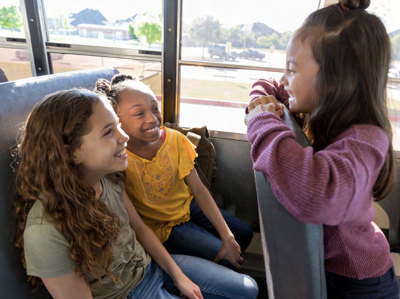
30% of all students nationwide (14.7 million) were chronically absent. Photo courtesy of the Annie E. Casey Foundation
Millions of kids nationwide and in California can be at risk of struggling throughout their adulthood if issues such as poor academic outcomes, chronic absenteeism and a lack of basic reading and math skills are not addressed, a new report shows.
The 2024 KIDS COUNT Data Book, released on June 10 by the Annie E. Casey Foundation, used 50-state data to call attention to students’ unprecedented drops in learning brought on by the COVID-19 pandemic.
“The COVID-19 pandemic wrought serious academic damage as it closed schools and separated students from their physical learning environment. Unprecedented drops in fourth-grade reading and eighth-grade math proficiency among students amounted to decades of lost progress,” Lisa M. Hamilton, president and chief executive officer of the Annie E. Casey Foundation, said. “We all want children to have the opportunity to fulfill their individual potential. We also need them to succeed if our country and our economy are to remain strong into the future.”
The databook, which gathers academic data from 2019 and 2022, derives a composite index of overall child well-being for each state by combining data across four domains: economic well-being, education, health and family and community. Consequently, California ranked in 35th place out of 50 states and was therefore rated among the “worst” states for overall children's well-being.
The data book also shows that while nationally, only one in three children are meeting reading standards in the fourth grade, one in four eighth graders are proficient in math and 30% of students are chronically absent, Latino students are far below even those national averages. Only 20% of Latino fourth-graders are proficient in reading, 14% of Latino eighth-graders are proficient in math and children of color are more likely to be chronically absent than white students.
Earlier this year, students and community-based organizations won a lawsuit against the State of California for failing to fulfill its constitutional duty to ensure equitable access to education, especially during the pandemic. In the settlement agreement of Cayla J. v. the State of California, school districts must direct at least $2 billion in funding to help students who fell behind during the COVID-19 pandemic catch up.
“The urgent vision of this historic settlement is not just to recoup the academic losses suffered by California’s most disadvantaged students, but to erase the opportunity gaps altogether exacerbated by the pandemic,” said Mark Rosenbaum, senior special counsel for strategic litigation at Public Counsel, the law firm that took on the case. “This is a victory of partnership among students, caregivers and community organizations with California’s leadership that recognizes that educational opportunity is the state’s greatest natural resource.”
Alberto Retana, chief executive officer of Community Coalition, a nonprofit organization based in South Los Angeles and one of the organizations that helped push the lawsuit forward, said the win was a way to address the inequities of low-income communities of color. “This is such a huge victory and much-deserved investment in California’s Black and Brown students who are still feeling the impacts of the COVID-19 pandemic,“ Retana said. “Community Coalition devised a virtual summer program targeting academics, technology, and wellness to provide for our students’ educational needs. Our approach considered English language and technological proficiency and other nuances that characterize the curriculums and educational inequities of South L.A. schools.”
Karina Jimenez Lewis, associate director of Policy Reform and Advocacy at the Annie E. Casey Foundation, said she hopes the report looks to move similar legislation forward, explaining that the statistics and reports in the 2024 KIDS COUNT Data Book come from public data gathered from places like the U.S. Department of Education, the American Community Survey, the National Center for Education Statistics, the National Assessment of Educational Progress (NAEP) and the U.S. Census Bureau, among others.
“We are very proud to present this data, which is publicly available data that is trustworthy and credible. We compile, organize, and compare the data that then becomes this report,” she told CALÒ News. “It is an effort to present decision-makers, legislators, agency leaders and the overall public with data that they can trust so that they can make the best decisions to support children as they develop and mature into young people.”
Other key findings from the 2024 KIDS COUNT Data Book showed that 30% of all students nationwide (14.7 million) were chronically absent, nearly double pre-pandemic rates (16% in 2018–19, the final school year fully unaffected by COVID-19). In addition, four out of ten students (40% of all students nationwide) had undergone at least one adverse childhood experience, such as family economic hardship or their parents having divorced, separated or served time in jail.
Jimenez Lewis said that racial inequities also play a big part in the academic well-being of students, as data suggests that oftentimes children of color, including Latino children, face deeper social and economic inequities that play a role in the lives of children.
“We see the disparities that children of color are facing. They are facing high hurdles to success, and so our nation is just not providing children of color, especially Latino children, with the opportunities and the support that they need to thrive,” Jimenez Lewis said.
According to the 2024 KIDS COUNT Data Book, Latino children make up the biggest number (61%) of young children (ages three and four) who are not in school, compared to the national average of 54%. In addition, 42% of Latino children in 2022 lived in single-parent families, followed by Black children, of whom 63% also lived in single-parent households. Latino children also make up the biggest number of children (25%) who are in families where the household head lacks a high school diploma in 2022, compared to the national average of11%.
The databook and report also established that families and parents' well-being is important to the academic growth and development of their children. In 2022, 26%, or 18.6 million children, lived in families where no parent had full-time, year-round employment.
“The COVID-19 pandemic pushed the unemployment rate to near-record highs and caused millions to leave the labor market. In 2022, job openings reached a record high as the labor market recovered,” as stated in the report. “Even so, employment insecurity is a reality for more than a quarter of families living in the United States. It disrupts daily living and relationships and limits families’ access to resources to invest in their children’s development, which can, in turn, diminish children’s achievement in school and chances of future success.
The report was published three months before many states, including California, must allocate their share of the $190 billion in critical federal pandemic funding known as Elementary and Secondary School Emergency Relief, or ESSER, that could help bridge the gap between academic excellence and the learning deficit in many communities. By September 30, states must allocate, not necessarily spend, the funding given to them.
In June 2023, EdSource reported that California school districts and charter schools had spent $5 billion of the $13.5 billion of ESSER III, the last and largest allotment of the Federal Elementary and Secondary School Emergency Relief Fund. The funds would help states with providing principals and other school leaders with the resources necessary to address the unique needs of their individual schools while addressing the unique needs of low-income children or students and children with disabilities. Funds could also be used for professional development in sanitation, purchasing supplies and purchasing educational technology, among other things.
“We really should engage and encourage policymakers to take advantage of all of the funding that was made available through the pandemic. Many states have not been spending this money, which could be of great help.” Jimenez Lewis said.
As part of the report, the Annie E. Casey Foundation also listed some of the organization's recommendations for the betterment of children and families across the country. The recommendations included encouraging policymakers, educators and schools to prioritize access to mental health care that accounts for young people’s different experiences and identities. Another recommendation was to ensure that students have access to intensive tutoring and for states and school systems to address the chronic absences of millions of students who are still not attending school or missing school days at alarming rates.
“Kids of all ages and grades must have what they need to learn each day, such as enough food and sleep and a safe way to get to school, as well as the additional resources they might need to perform at their highest potential and thrive, like tutoring and mental health services,” Hamilton, said. “Our policies and priorities have not focused on these factors in preparing young people for the economy, short-changing a whole generation.”
The 2024 KIDS COUNT Data Book is available at www.aecf.org











(0) comments
Welcome to the discussion.
Log In
Keep it Clean. Please avoid obscene, vulgar, lewd, racist or sexually-oriented language.
PLEASE TURN OFF YOUR CAPS LOCK.
Don't Threaten. Threats of harming another person will not be tolerated.
Be Truthful. Don't knowingly lie about anyone or anything.
Be Nice. No racism, sexism or any sort of -ism that is degrading to another person.
Be Proactive. Use the 'Report' link on each comment to let us know of abusive posts.
Share with Us. We'd love to hear eyewitness accounts, the history behind an article.